
How to Use DFPlayer Mini Mp3 Player KeeYees: Examples, Pinouts, and Specs
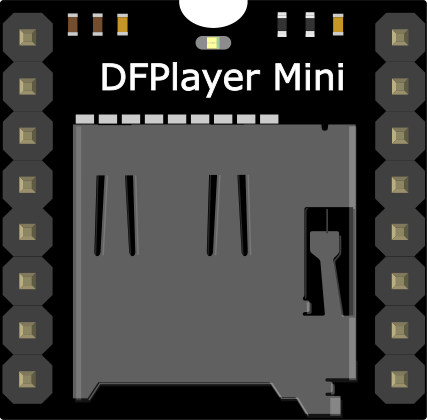
 Design with DFPlayer Mini Mp3 Player KeeYees in Cirkit Designer
Design with DFPlayer Mini Mp3 Player KeeYees in Cirkit DesignerIntroduction
The DFPlayer Mini MP3 Player KeeYees (Part ID: KYES65-KIT) is a compact and versatile MP3 player module designed for audio playback in DIY electronics projects. It supports audio files stored on a micro SD card and features a built-in amplifier, making it ideal for standalone or microcontroller-based applications. The module is compatible with various audio formats, including MP3, WAV, and WMA, and can be controlled via serial communication or standalone mode.
Explore Projects Built with DFPlayer Mini Mp3 Player KeeYees
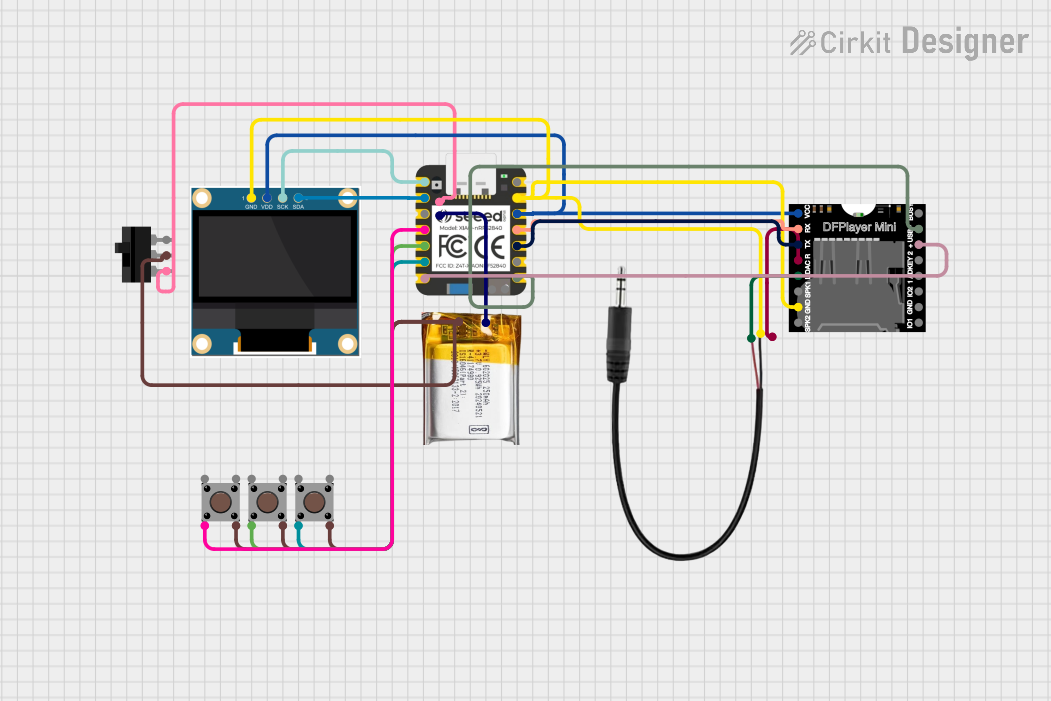
 Open Project in Cirkit Designer
Open Project in Cirkit Designer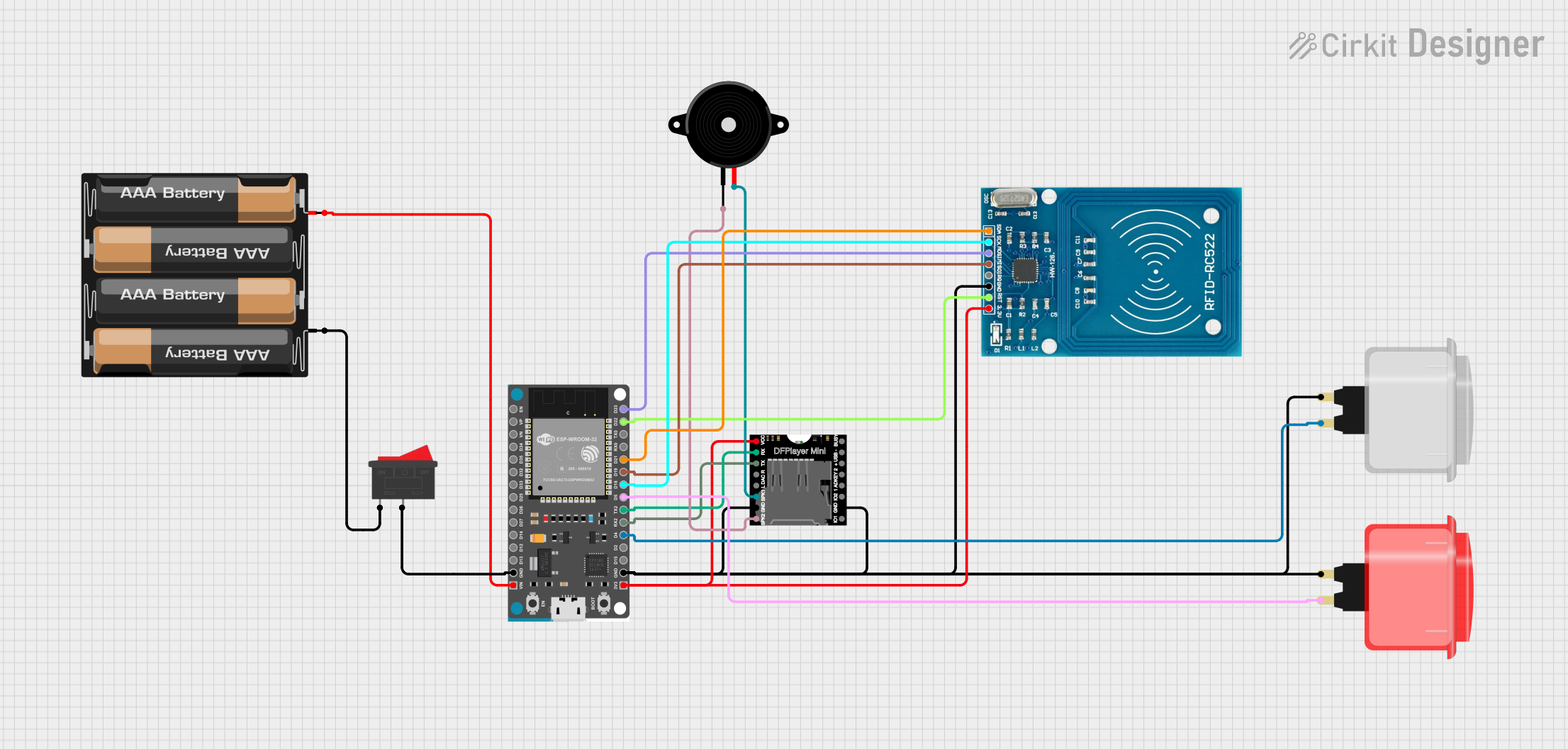
 Open Project in Cirkit Designer
Open Project in Cirkit Designer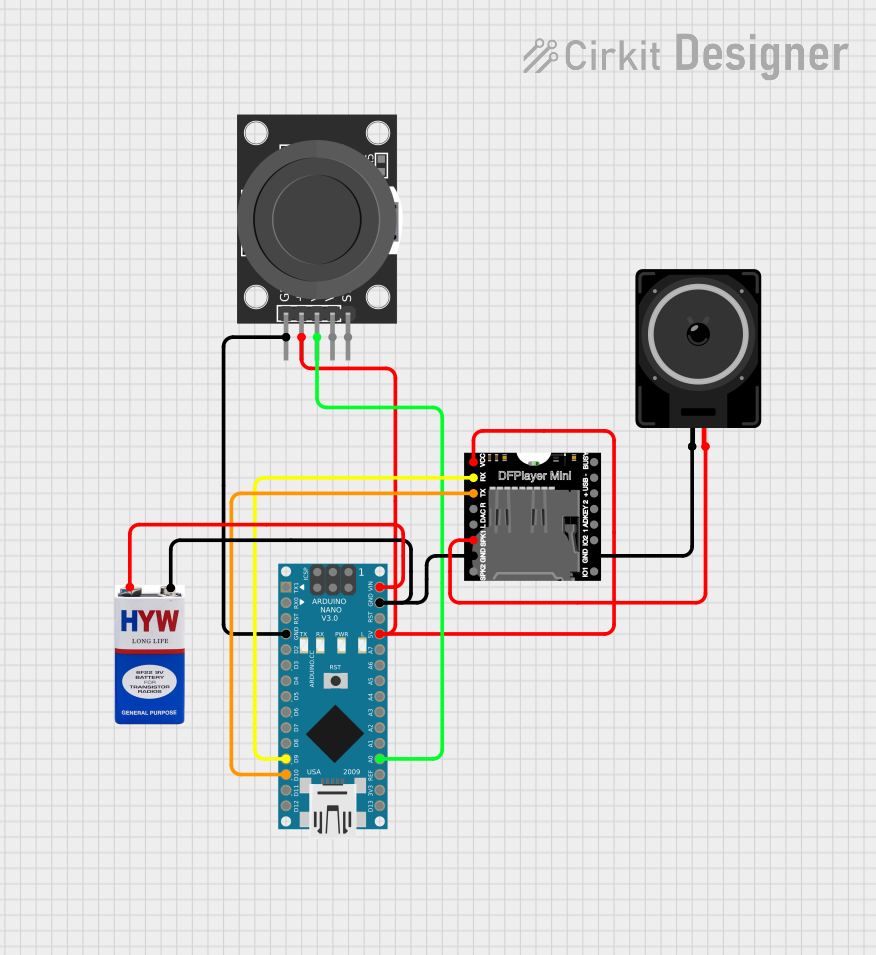
 Open Project in Cirkit Designer
Open Project in Cirkit Designer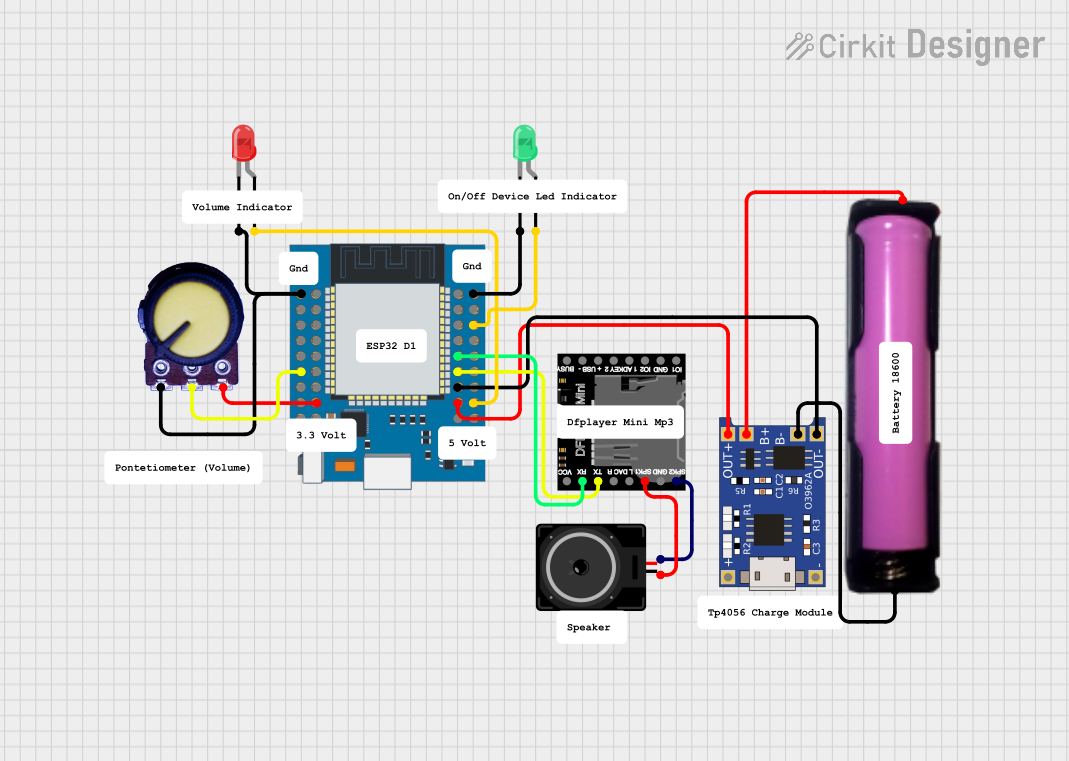
 Open Project in Cirkit Designer
Open Project in Cirkit DesignerExplore Projects Built with DFPlayer Mini Mp3 Player KeeYees

 Open Project in Cirkit Designer
Open Project in Cirkit Designer
 Open Project in Cirkit Designer
Open Project in Cirkit Designer
 Open Project in Cirkit Designer
Open Project in Cirkit Designer
 Open Project in Cirkit Designer
Open Project in Cirkit DesignerCommon Applications and Use Cases
- DIY audio systems and portable speakers
- Voice prompts and sound effects in embedded systems
- Interactive art installations
- Alarm systems with audio notifications
- Educational projects and Arduino-based audio applications
Technical Specifications
Key Technical Details
- Operating Voltage: 3.2V to 5.0V DC
- Current Consumption: 20mA to 30mA (idle), up to 100mA (playback)
- Audio Formats Supported: MP3, WAV, WMA
- Storage: Micro SD card (up to 32GB, FAT16/FAT32 file system)
- Output Options:
- Stereo audio output via DAC pins
- Mono amplified output via onboard speaker pins
- Control Modes: Serial communication (UART), AD key control, or standalone mode
- Built-in Amplifier: 3W mono output for direct speaker connection
- Dimensions: 22mm x 30mm x 11mm
Pin Configuration and Descriptions
The DFPlayer Mini has 16 pins, as described in the table below:
| Pin Name | Pin Number | Description |
|---|---|---|
| VCC | 1 | Power supply input (3.2V to 5.0V DC). |
| RX | 2 | UART serial communication input (connect to microcontroller TX pin). |
| TX | 3 | UART serial communication output (connect to microcontroller RX pin). |
| DAC_R | 4 | Right channel stereo audio output (DAC). |
| DAC_L | 5 | Left channel stereo audio output (DAC). |
| SPK_1 | 6 | Positive terminal for mono speaker output (3W max). |
| SPK_2 | 7 | Negative terminal for mono speaker output. |
| IO_1 | 8 | General-purpose input/output pin 1. |
| IO_2 | 9 | General-purpose input/output pin 2. |
| ADKEY_1 | 10 | Analog key input for standalone control. |
| ADKEY_2 | 11 | Analog key input for standalone control. |
| BUSY | 12 | Output pin indicating playback status (LOW = playing, HIGH = idle). |
| GND | 13 | Ground connection. |
| SD | 14 | Micro SD card slot for audio file storage. |
| RESET | 15 | Reset pin (active LOW). |
| NC | 16 | Not connected. |
Usage Instructions
How to Use the Component in a Circuit
- Power Supply: Connect the VCC pin to a 3.2V–5.0V DC power source and GND to ground.
- Audio Output:
- For stereo output, connect DAC_R and DAC_L to an external amplifier or headphones.
- For mono output, connect SPK_1 and SPK_2 to a speaker (3W max).
- Microcontroller Connection:
- Connect the RX pin of the DFPlayer Mini to the TX pin of the microcontroller.
- Connect the TX pin of the DFPlayer Mini to the RX pin of the microcontroller.
- Micro SD Card:
- Format the micro SD card to FAT16 or FAT32.
- Load audio files onto the card, ensuring filenames are in the format
0001.mp3,0002.mp3, etc. - Insert the card into the SD slot on the module.
- Control:
- Use UART serial commands for precise control via a microcontroller.
- Alternatively, use AD key inputs for standalone operation.
Important Considerations and Best Practices
- Ensure the power supply is stable and within the specified voltage range to avoid damage.
- Use a decoupling capacitor (e.g., 100µF) across the VCC and GND pins to reduce noise.
- Avoid connecting both DAC and SPK outputs simultaneously to prevent signal interference.
- Use a resistor divider or level shifter if connecting to a 5V logic microcontroller to protect the RX pin.
Example: Connecting to an Arduino UNO
Below is an example of how to connect and control the DFPlayer Mini with an Arduino UNO:
Circuit Diagram
- VCC → 5V on Arduino
- GND → GND on Arduino
- RX → Pin 10 on Arduino (via a 1kΩ resistor for level shifting)
- TX → Pin 11 on Arduino
Arduino Code
#include "SoftwareSerial.h"
// Define RX and TX pins for SoftwareSerial
SoftwareSerial mySerial(10, 11); // RX, TX
void setup() {
mySerial.begin(9600); // Initialize DFPlayer Mini communication
Serial.begin(9600); // Initialize Serial Monitor for debugging
// Send initialization commands to DFPlayer Mini
mySerial.write(0x7E); // Start byte
mySerial.write(0xFF); // Version
mySerial.write(0x06); // Length
mySerial.write(0x09); // Command: Select device
mySerial.write(0x00); // Feedback
mySerial.write(0x02); // Parameter: SD card
mySerial.write(0xEF); // End byte
Serial.println("DFPlayer Mini initialized.");
}
void loop() {
// Example: Play the first track
mySerial.write(0x7E); // Start byte
mySerial.write(0xFF); // Version
mySerial.write(0x06); // Length
mySerial.write(0x03); // Command: Play track
mySerial.write(0x00); // Feedback
mySerial.write(0x00); // High byte of track number
mySerial.write(0x01); // Low byte of track number (Track 1)
mySerial.write(0xEF); // End byte
delay(5000); // Wait for 5 seconds before replaying
}
Troubleshooting and FAQs
Common Issues and Solutions
No Sound Output:
- Ensure the micro SD card is properly formatted and inserted.
- Verify that audio files are named correctly (e.g.,
0001.mp3). - Check speaker connections and ensure the speaker is within the 3W limit.
Module Not Responding:
- Confirm the power supply voltage is within the 3.2V–5.0V range.
- Check UART connections and ensure RX/TX pins are correctly wired.
- Use a level shifter if the microcontroller operates at 5V logic.
Playback Stops Unexpectedly:
- Ensure the micro SD card is not corrupted.
- Use a high-quality micro SD card with a fast read speed.
Distorted Audio:
- Reduce the volume using UART commands if the speaker is overdriven.
- Use an external amplifier for better audio quality.
FAQs
Can I use the DFPlayer Mini without a microcontroller? Yes, the module supports standalone mode using AD key inputs.
What is the maximum supported micro SD card size? The module supports micro SD cards up to 32GB formatted as FAT16 or FAT32.
Can I connect headphones directly to the module? Yes, use the DAC_R and DAC_L pins for stereo headphone output.
Is the module compatible with 3.3V logic microcontrollers? Yes, the module works with both 3.3V and 5V logic levels.